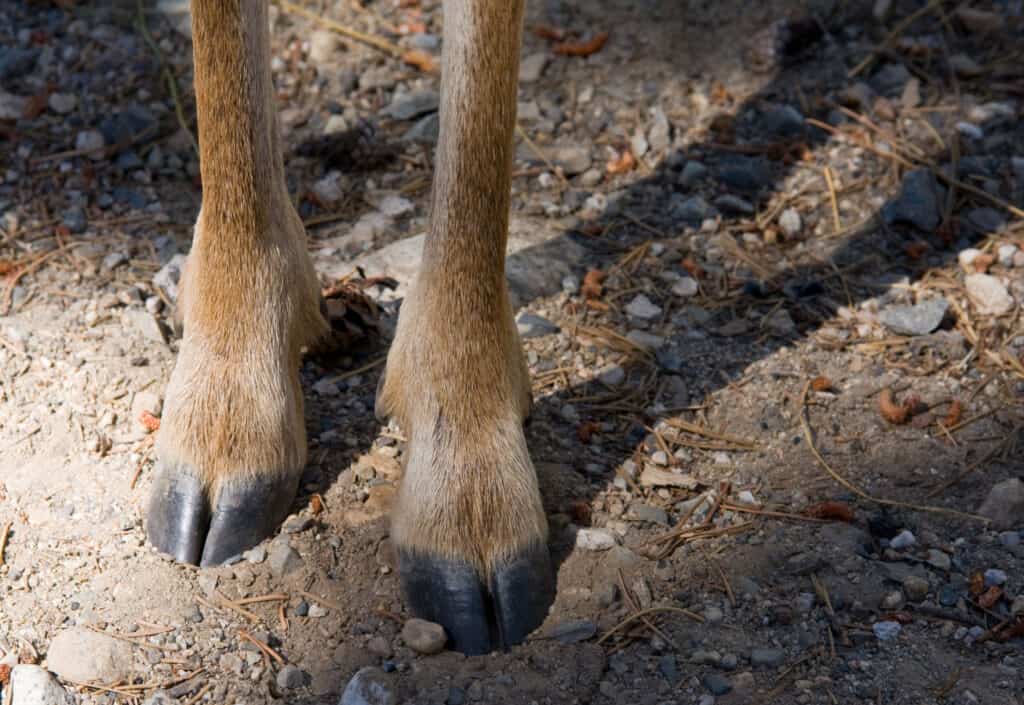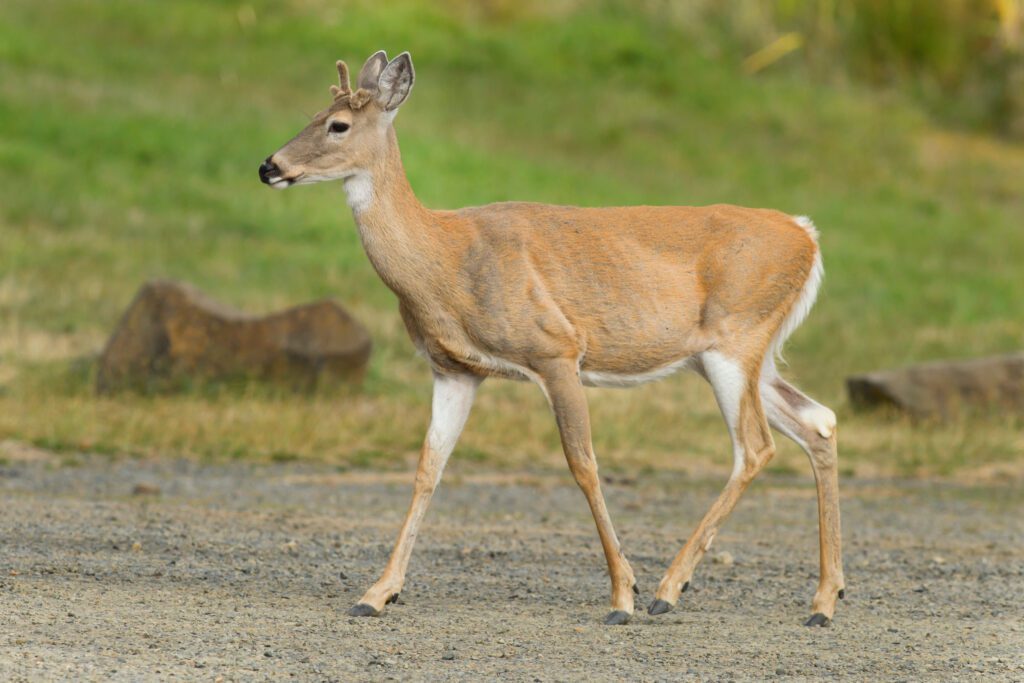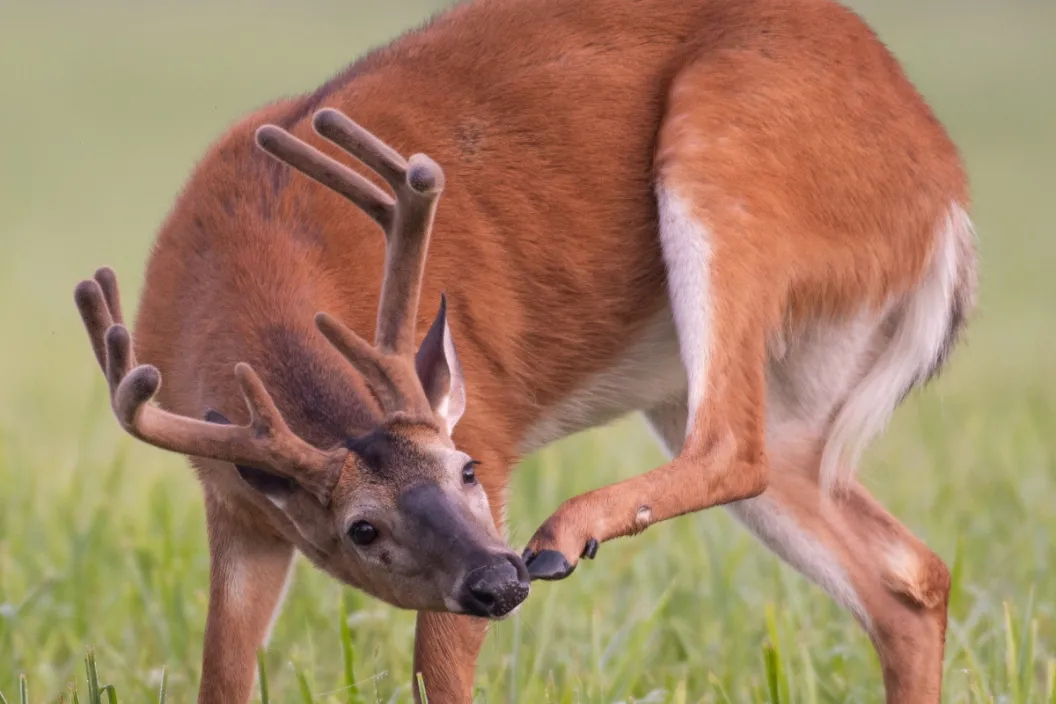Are you curious about the fascinating world of deer hooves? Well, you’re in for a treat! In this blog post, we’re going to dive deep into the world of deer feet and uncover all the secrets they hold. Whether you’re an animal enthusiast, a hunter, or simply someone who appreciates the wonders of nature, this article is for you. From understanding the anatomy of deer hooves to exploring their functionality and unique features, we’ll leave no stone unturned. So, get ready to embark on a hoof-tastic journey and discover what makes deer feet so extraordinary. Let’s jump right in and explore all there is to know about deer hooves!
Understanding the Anatomy of Deer Hooves
Just like humans wear shoes to protect their feet, nature has equipped deer, amongst other ungulates, with a sturdy pair of hooves. These hooves define their identity in the wild, serving as their primary means of navigation and defense. The term ‘ungulate’ is derived from the Latin word ‘ungula,’ meaning ‘hoof.’ As ungulate mammals, deer possess these hard, horny coverings that shield their toes. These protective structures are akin to our fingernails but are composed of a denser, keratin material that is ever-growing.
Read more about: Are These the 10 Largest Wolves on the Planet? Unveiling the Mighty Beasts
Picture the scene: a deer elegantly prancing around in the woods, its hooves perfectly in sync with the rhythm of nature. These hooves are not just a part of the deer’s body; they are an embodiment of their lifestyle and their survival instinct. The design and size of a hoof can differ among species, being a perfect adaptation to their specific needs and surroundings. The hooves of deer, for instance, are cloven or split into two sections, each unit of which is aptly called a “digit.”
| Fact | Description |
|---|---|
| What are Hooves? | Hooves are hard, horny coverings that protect the toes of ungulate mammals. |
| Adaptation of Deer Hooves | Deer hooves are specially adapted for their lifestyle, allowing deer to navigate various terrains, from rocky hillsides to muddy fields. |
| Hooves Growth | Deer hooves grow continuously, similar to human nails. |
| Structure of Deer Hooves | Deer hooves are divided into two sections, or “toes,” each of which is called a “digit.” |
| Classification of Deer | Deer belong to the even-toed ungulates group. |
In the grand tapestry of the animal kingdom, the hooves of a deer hold a special place, not only for their unique structure but also for their role in the deer’s biology. As we delve deeper into the world of deer hooves, you’ll discover how their feet are a gateway to understanding these graceful creatures better.
The Functionality of Deer Hooves

deer hooves
When you first glance at a deer, you may not immediately think about the importance of its hooves. Yet, these seemingly simple parts play a pivotal role in the deer’s survival. Much more than just a protective covering for the deer’s feet, hooves are the unsung heroes of the deer’s anatomy. They provide a foundation for the deer’s weight, offering support and stability. Let’s delve deeper into the fascinating world of deer hooves and their functionality.
Imagine a deer sprinting through a dense forest, leaping over logs and darting between trees. It’s a marvel of nature, isn’t it? Now, imagine that same deer navigating a rocky hillside or a muddy field. How does it move so swiftly, without losing its footing? The answer lies in the unique design of its hooves.
Read more: Are Deer Friendly? Exploring Their Surprising Affection Towards Humans
Deer hooves are cloven, meaning they are split into two parts. This structure is a masterstroke of evolution, providing the deer with excellent traction. The cloven nature of deer hooves enables them to grip the ground effectively, even on slippery or uneven terrains. This is crucial when fleeing from predators, where a single misstep could mean the difference between life and death.
Also check out: Leopard vs. Cougar: What Makes Them Different and Who Prevails in a Battle?
Moreover, deer hooves grow continuously throughout their lives, much like our nails. This is a necessary adaptation as the hooves wear down naturally due to the deer’s constant movement. The endless cycle of growth and wear ensures the deer’s hooves are always in optimal condition.
Defense is another crucial aspect of deer hooves’ functionality. When cornered, a deer can use its hooves to strike out against predators, making them formidable weapons. Not many predators would risk the sharp kick of a fully-grown deer!
Lastly, let’s not forget the role of deer hooves in communication. The sound of a deer stomping its hooves can serve as a warning to other deer, signaling danger. This simple, yet effective means of communication is another testament to the multifaceted functionality of deer hooves.
In conclusion, from providing support and traction to serving as a means of defense and communication, the functionality of deer hooves is truly remarkable. So, the next time you see a deer gracefully bounding across a field, remember, it’s all in the hooves!
Unique Features of Deer Hooves
Have you ever marveled at the grace of a deer as it lithely navigates treacherous terrains? Much of this agility can be attributed to the unique structure of their hooves. Deer hooves are not just ordinary appendages; they are sophisticated tools that have evolved over time to support their survival.
At the heart of this adaptability is the “sole” – a thick, rubbery pad that envelops the bottom of the deer’s hoof. This sole serves as a natural shock absorber, allowing deer to bound effortlessly over uneven surfaces. It also equips them with traction, ensuring secure footing on slippery slopes or muddy fields. Just imagine how handy this would be the next time you find yourself navigating a rocky hillside!
It’s fascinating how nature has equipped deer hooves with mechanisms that not only support movement but also aid in communication and survival.
Hidden between the cloven hooves are interdigital scent glands. These glands secrete a unique scent, a sort of olfactory fingerprint, that is left behind with every step a deer takes. This scent plays a pivotal role in deer communication, marking trails, and even attracting mates. Wildlife biologists often analyze these scents to gather valuable information about deer behavior and ecology.
As the harsh winter sets in, deer hooves undergo a subtle transformation. They grow longer and thicker, providing a protective barrier against the biting cold and snow. This is nature’s way of equipping deer with their very own snowshoes!
During the breeding season, bucks employ their hooves in a unique way to mark their territory. They scrape the ground to create a “scrape”, and then urinate in it. This combination of physical marking and scent leaves a potent message for other deer, signifying the buck’s presence and dominance.
For more similar posts check out: What Eats Tigers? Discover the Top Predators That Prey on Tigers as well as Are Lions Friendly or Fierce? Unveiling the Truth about Their Nature and Interaction with Humans
From providing stability to facilitating communication, the unique features of deer hooves are a testament to the marvels of evolution. They reveal how intricately nature has designed these creatures for survival, making them a source of fascination for wildlife enthusiasts and biologists alike.
Hooves as a Key to Deer’s Biology
Just as the vibrant rings of a tree stump narrate the tale of a tree’s life, the hooves of a deer can reveal a fascinating story of its own. If you’ve ever pondered upon the life of this majestic creature, you’ll be intrigued to know that a deer’s hooves hold the key to unlock its age, health status, and even its sex. This is an extraordinary aspect of deer biology that wildlife biologists utilize to uncover the hidden truths of a deer’s life.
Wildlife biologists, akin to detectives in the wild, meticulously examine the hooves’ wear patterns and growth rate. Much like the way a map guides a traveler, these patterns provide invaluable information about a deer’s journey through life. The ebb and flow of growth rates can help determine the age of the deer. The wear and tear patterns, on the other hand, are indicative of the deer’s overall health, reflecting their nutritional status and the challenges they have faced in their environment.
But that’s not all. The hoof prints left behind by a deer can also serve as a gender identifier. Buck tracks and doe tracks are distinguishable based on unique factors such as size, shape, and behavior. It’s a fascinating fact that buck tracks are generally larger than doe tracks. This size difference is attributable to males typically being heavier and larger than females. Furthermore, the shape of their tracks also differs. Buck tracks, for instance, tend to be more pointed and elongated than those of does, revealing the intriguing detail that male deer’s hooves are often longer and narrower than those of females.
Ever noticed how the footprints left behind by a human runner differ from those of a casual walker? A similar phenomenon occurs with deer. Bucks, for instance, tend to have a longer stride than does, resulting in tracks that may be spaced farther apart. This subtle but significant detail can offer insights into their behavior.
Read more: Why Do Fawns Lose Their Spots and What is the Purpose of Their Spots?
Interestingly, the behavior of bucks and does varies noticeably during the rutting season. Bucks become more active during the day and move around more frequently, resulting in more visible and numerous tracks. This behavioral change is a telltale sign of the rutting season, which wildlife enthusiasts and hunters keenly observe.
In the grand tapestry of nature, every detail matters. The humble deer hoof, often overlooked, is indeed a treasure chest of biological secrets. As we delve deeper into the world of deer hooves, we come to appreciate the remarkable adaptability and resilience of these creatures, thus gaining a deeper understanding of their biology and their role in the ecosystem.
Hooves in the Animal Kingdom

deer
It’s a captivating thought, isn’t it? The way nature equips us to survive and thrive in our environments. Just as we humans take pride in our nimble fingers, the animal kingdom boasts an array of creatures who owe their survival to their hooves. These sturdy structures, often overlooked, are integral to the life of many species. They are not just their “shoes”, but a testament to their evolutionary journey.
Imagine the wide, arid plains of Africa, home to the mighty giraffe and antelope. Their hooves, designed for speed and agility, give them a fighting chance against predators. Picture the mountainous regions, the natural habitat of goats and sheep. Their hooves are adapted for climbing and stability, allowing them to navigate treacherous terrain. Even the hippopotamus, despite its aquatic lifestyle, relies on its hooves for locomotion on land.
Hooves are the footwear of the animal world, a perfect blend of form and function. These structures provide a solid and stable base for animals to walk, run, and even jump over varied landscapes. The shape and structure of hooves are specifically designed to allow for efficient movement over diverse types of terrain, from the soft sands of deserts to the slippery slopes of mountains.
Check out: Are These 18 Beautiful Animals Really Deer? Discover the Surprising Lookalikes
Animals with hooves are referred to as ungulates. This classification aligns them into two distinct groups based on the number of toes on each limb. Odd-toed ungulates, or Perissodactyla, are animals with one or three toes on each limb. You would find species such as donkeys, horses, rhinoceroses, zebras, and tapirs in this group. Their uneven number of toes provide unique advantages in their respective habitats.
On the other hand, even-toed ungulates, or Artiodactyla, have two or four toes on each leg. This group includes a wide range of species such as deer, pigs, sheep, antelopes, giraffes, cattle, camels, goats, and hippopotamuses. The even number of toes in these animals improves their stability and balance, vital to their survival.
Hooves, in their unique ways, speak volumes about the life and times of these remarkable creatures. They are a symbol of their resilience, their adaptability, and their will to survive. As we continue our exploration of deer hooves, let’s remember this fascinating journey of hooves across the animal kingdom.
The Significance of Deer Hooves
Have you ever wondered why deer are so agile, able to dart away at a moment’s notice or navigate treacherous terrain with seemingly effortless grace? The answer lies in their hooves, those remarkable tools of nature that are so often overlooked. Deer hooves are more than just ‘feet’ – they are a testament to the power of evolution and an essential adaptation that enables deer to thrive in their various habitats.
Picture a deer in its natural environment. The uneven terrain, the sudden need for speed when a predator approaches, the challenges of foraging for food on slippery ground. Now, imagine how much more difficult all of these tasks would be without specially adapted hooves. The cloven structure of deer hooves allows them to move with effortless agility, even on rocky hillsides and muddy fields.
As deer age, the outer edges of their hooves exhibit signs of wear and tear. They become somewhat blunt, yet remain sharp enough to cause harm if necessary. This blunting is a natural process, showcasing the deer’s active lifestyle and the constant challenges they face in the wild.
Check out: How Strong Are Orangutans? Discover Their Astonishing Power!
Did you know that deer have two sets of ankles? This unique feature is a key part of their mobility, allowing deer to move quickly and change direction in an instant. The ankle joint acts as a shock absorber, evenly distributing the deer’s body weight and significantly reducing the risk of leg injuries. It’s a testament to nature’s ingenuity and the deer’s resilience.
The bottom of a deer’s hoof, or the “sole”, plays a crucial role as well. Covered in a thick, rubbery pad, it provides traction and helps absorb shock. Wildlife biologists often study these soles to gain insights into a deer’s age, diet, and overall health.
The significance of deer hooves extends beyond their practical function. They symbolize the adaptability and resilience of these graceful creatures, providing a window into their biology and behavior.
So, the next time you see a deer bounding away in the distance, take a moment to appreciate the wonders of nature and the incredible design of deer hooves. Their ability to navigate uneven terrain, escape predators, and survive in various habitats is a testament to their evolutionary success and the power of adaptation.
Conclusion
As we delve deeper into the fascinating world of deer hooves, it becomes increasingly evident how vital these seemingly simple structures are to the survival and prosperity of deer. Like well-engineered boots designed for extreme environments, deer hooves are a testament to the power of nature’s design. With their cloven structure, they serve as the perfect tool for navigating the diverse terrains these graceful creatures call home, from rocky hillsides to the slippery mud of forest floors.
The hoof’s sole, a thick, rubbery pad that cushions each step, absorbs shock, and provides crucial traction, is remarkably akin to the tread on our own footwear. This efficient design allows deer to swiftly evade predators, a feat that underscores their survival in the wild. By studying the anatomy of a deer’s hoof, we gain a deeper appreciation for these animals’ adaptability and resilience.
Yet, the importance of hooves extends beyond movement. They play an essential role in communication among deer and serve as a formidable defense mechanism when threatened. These multi-purpose tools, evolved over millennia, reflect the intricate balance between an animal and its environment.
“Deer hooves are not just feet; they are the key to understanding the deer’s biology and a testament to their survival in diverse habitats.”
As we continue exploring the fascinating world of deer hooves, let’s remember that these incredible structures are not mere adaptations but rather, they are living proof of nature’s ingenuity. Through the prism of understanding deer hooves, we can deepen our respect for deer and the natural world they inhabit.
Deer hooves are split into two sections, or “toes,” and each unit is called a “digit.”
Deer hooves are essential for providing support and traction when running and defending against predators. They also help deer navigate rocky hillsides and muddy fields.
Deer hooves grow continuously throughout their life and wear down naturally as the deer moves around. In winter, they grow longer and thicker to provide better insulation against the cold and snow.
Wildlife biologists can examine the wear patterns and growth rate of a deer’s hooves to determine its age, sex, and overall health.

